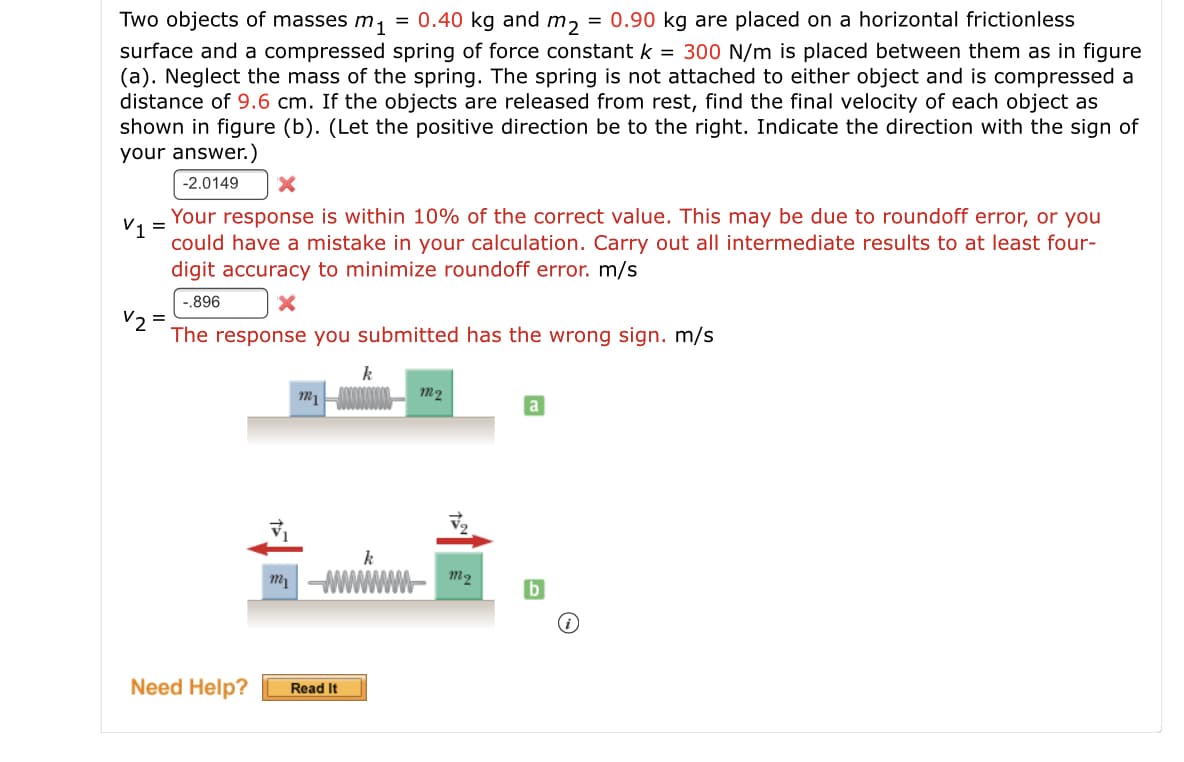Two objects of masses m, = 0.40 kg and m,2 = 0.90 kg are placed on a horizontal frictionless surface and a compressed spring of force constant k = 300 N/m is placed between them as in figure (a). Neglect the mass of the spring. The spring is not attached to either object and is compressed a distance of 9.6 cm. If the objects are released from rest, find the final velocity of each object as shown in figure (b). (Let the positive direction be to the right. Indicate the direction with the sign of your answer.)
Two objects of masses m, = 0.40 kg and m,2 = 0.90 kg are placed on a horizontal frictionless surface and a compressed spring of force constant k = 300 N/m is placed between them as in figure (a). Neglect the mass of the spring. The spring is not attached to either object and is compressed a distance of 9.6 cm. If the objects are released from rest, find the final velocity of each object as shown in figure (b). (Let the positive direction be to the right. Indicate the direction with the sign of your answer.)
Principles of Physics: A Calculus-Based Text
5th Edition
ISBN:9781133104261
Author:Raymond A. Serway, John W. Jewett
Publisher:Raymond A. Serway, John W. Jewett
Chapter8: Momentum And Collisions
Section: Chapter Questions
Problem 60P: A cannon is rigidly attached to a carriage, which can move along horizontal rails but is connected...
Related questions
Question

Transcribed Image Text:Two objects of masses m1
= 0.40 kg and m2
0.90 kg are placed on a horizontal frictionless
surface and a compressed spring of force constant k = 300 N/m is placed between them as in figure
(a). Neglect the mass of the spring. The spring is not attached to either object and is compressed a
distance of 9.6 cm. If the objects are released from rest, find the final velocity of each object as
shown in figure (b). (Let the positive direction be to the right. Indicate the direction with the sign of
your answer.)
-2.0149
Your response is within 10% of the correct value. This may be due to roundoff error, or you
V1 =
could have a mistake in your calculation. Carry out all intermediate results to at least four-
digit accuracy to minimize roundoff error. m/s
-.896
V2
The response you submitted has the wrong sign. m/s
m2
a
m -WWWWW
m2
b
Need Help?
Read It
Expert Solution
This question has been solved!
Explore an expertly crafted, step-by-step solution for a thorough understanding of key concepts.
This is a popular solution!
Trending now
This is a popular solution!
Step by step
Solved in 4 steps

Knowledge Booster
Learn more about
Need a deep-dive on the concept behind this application? Look no further. Learn more about this topic, physics and related others by exploring similar questions and additional content below.Recommended textbooks for you

Principles of Physics: A Calculus-Based Text
Physics
ISBN:
9781133104261
Author:
Raymond A. Serway, John W. Jewett
Publisher:
Cengage Learning

University Physics Volume 1
Physics
ISBN:
9781938168277
Author:
William Moebs, Samuel J. Ling, Jeff Sanny
Publisher:
OpenStax - Rice University

Classical Dynamics of Particles and Systems
Physics
ISBN:
9780534408961
Author:
Stephen T. Thornton, Jerry B. Marion
Publisher:
Cengage Learning

Principles of Physics: A Calculus-Based Text
Physics
ISBN:
9781133104261
Author:
Raymond A. Serway, John W. Jewett
Publisher:
Cengage Learning

University Physics Volume 1
Physics
ISBN:
9781938168277
Author:
William Moebs, Samuel J. Ling, Jeff Sanny
Publisher:
OpenStax - Rice University

Classical Dynamics of Particles and Systems
Physics
ISBN:
9780534408961
Author:
Stephen T. Thornton, Jerry B. Marion
Publisher:
Cengage Learning